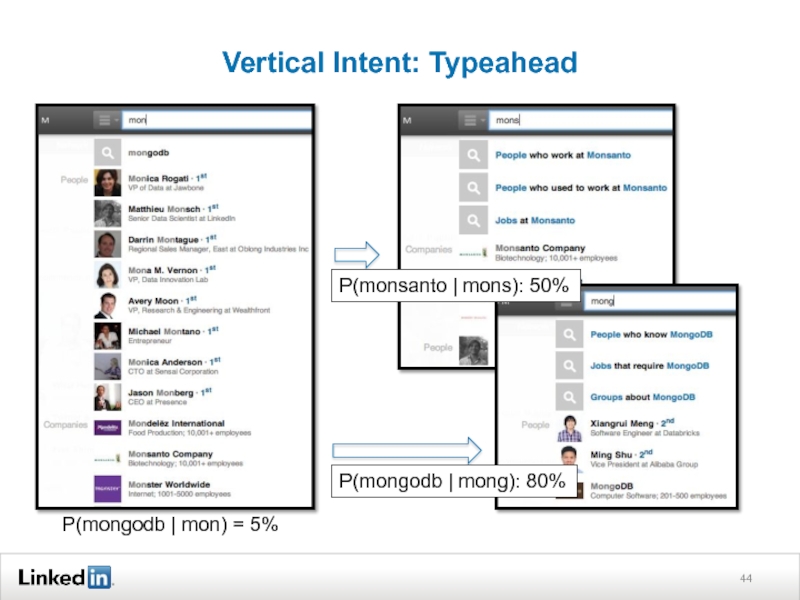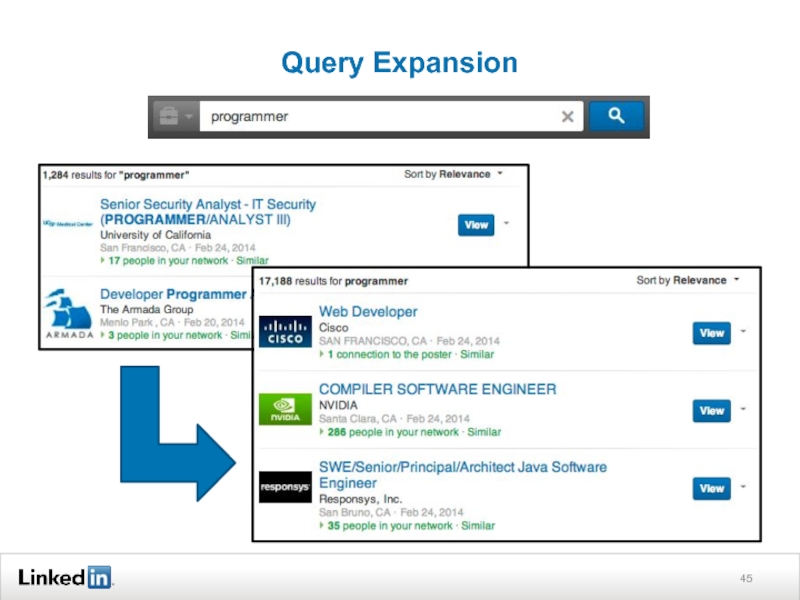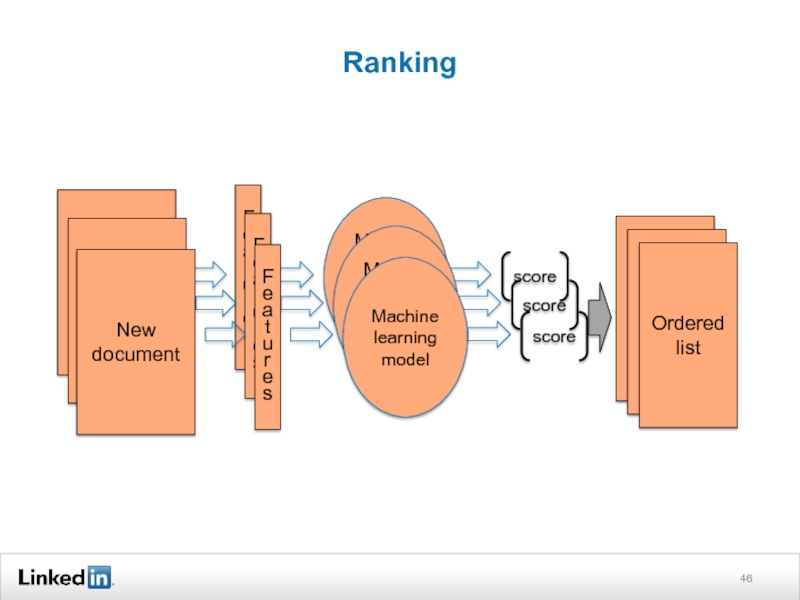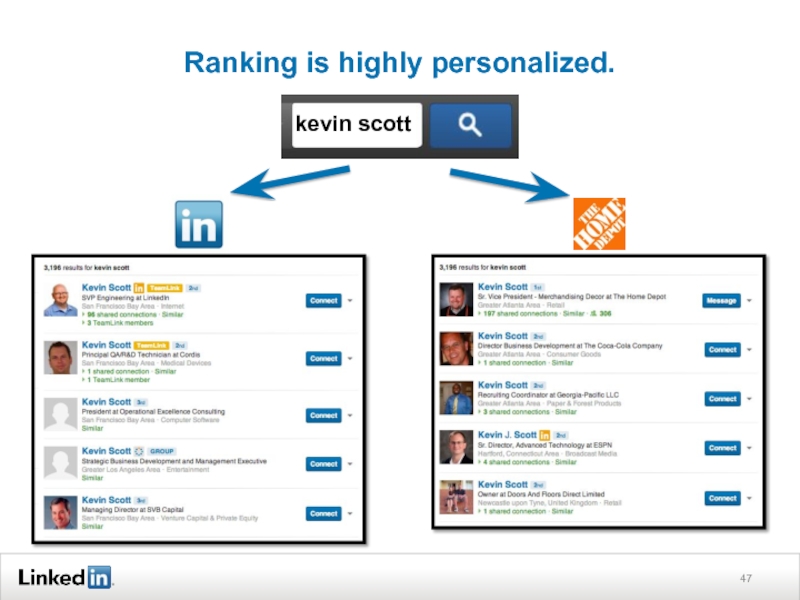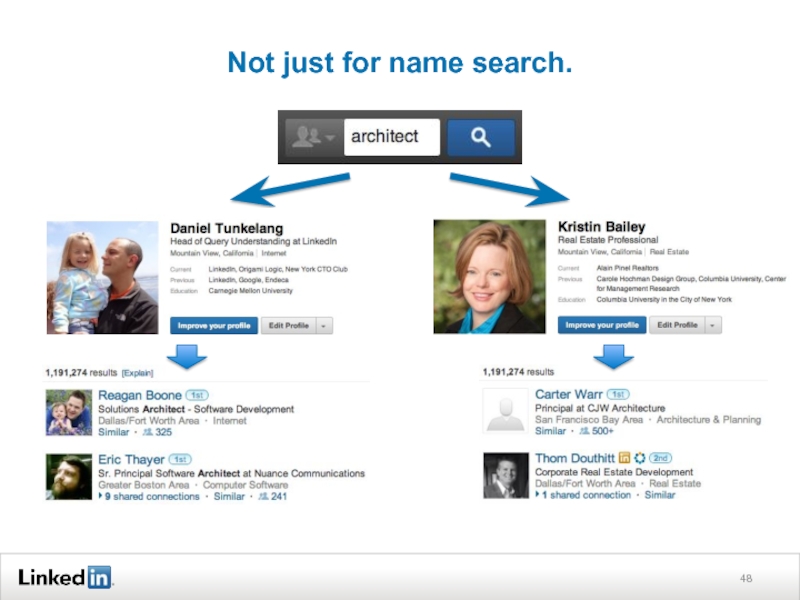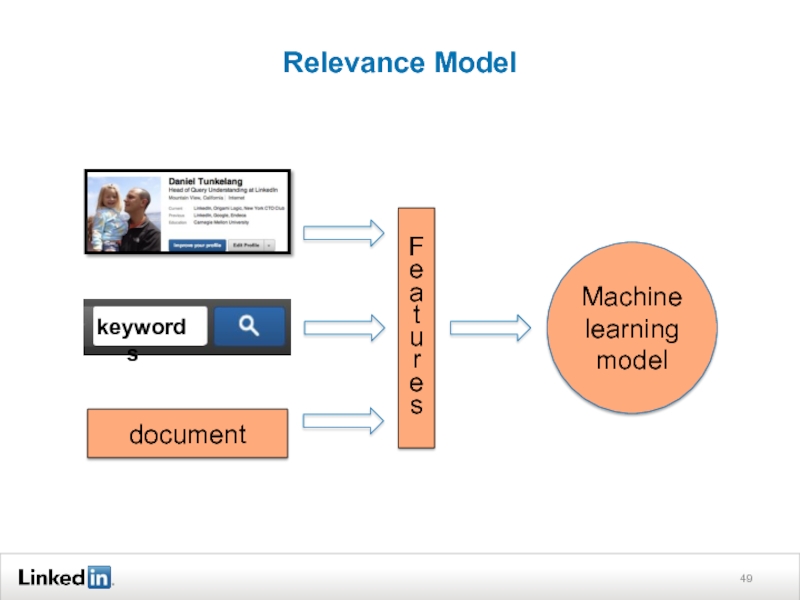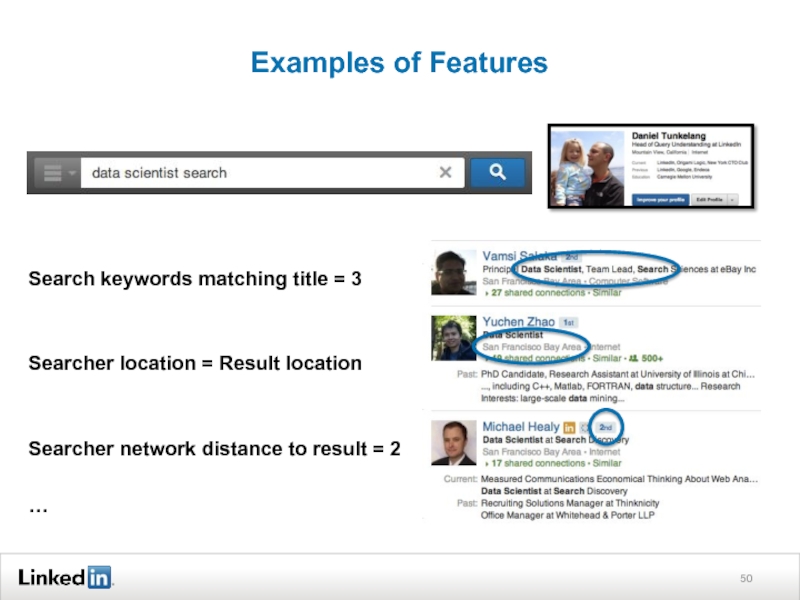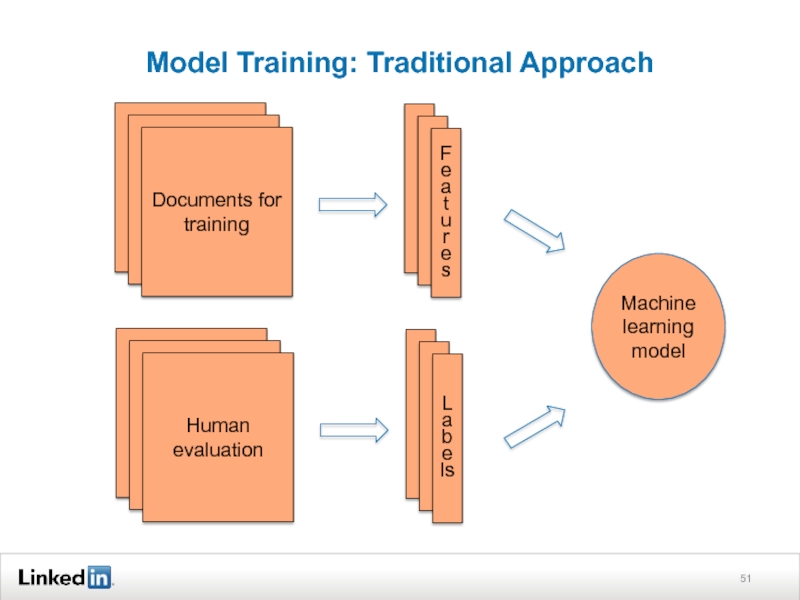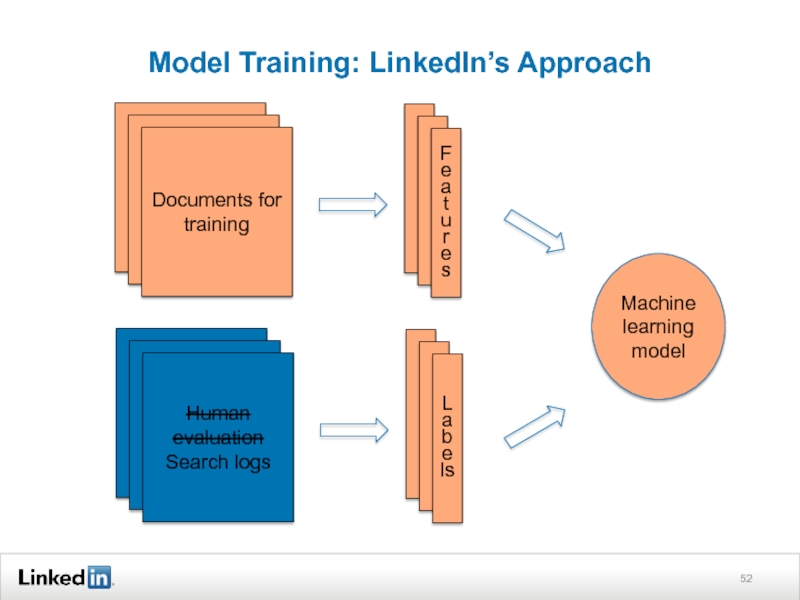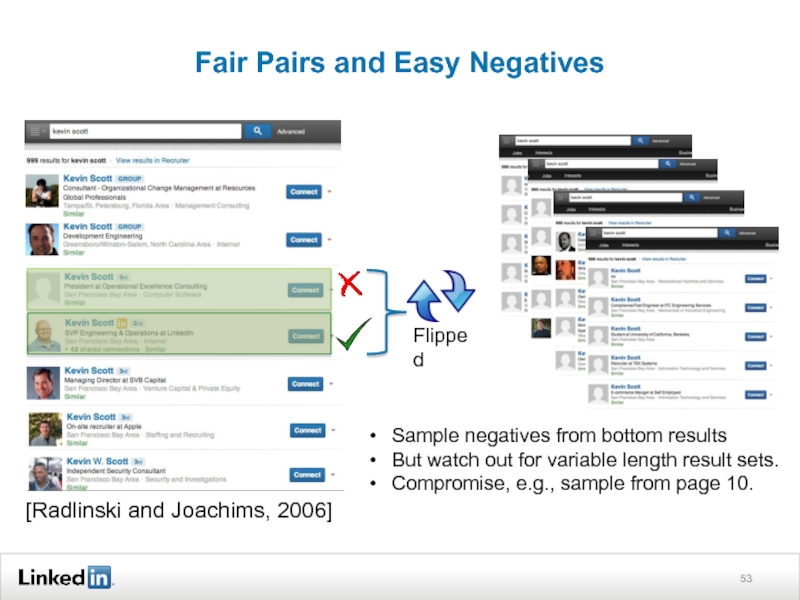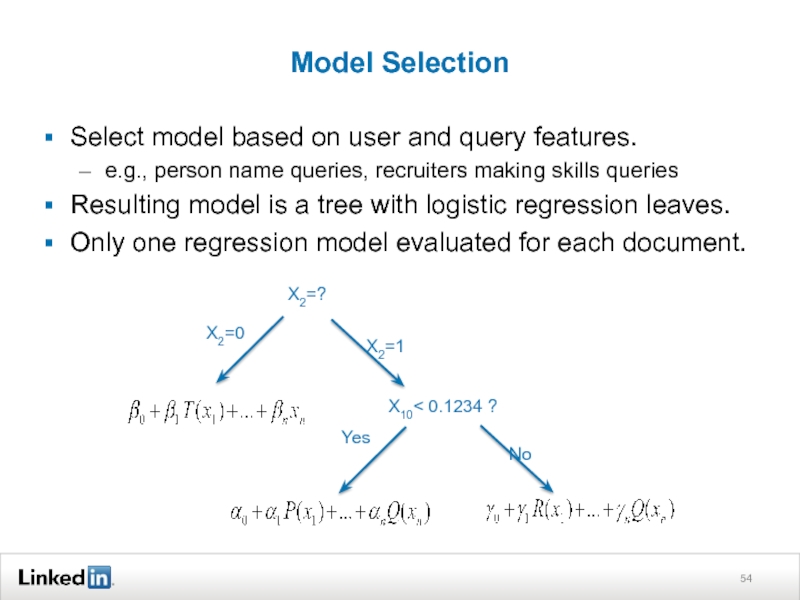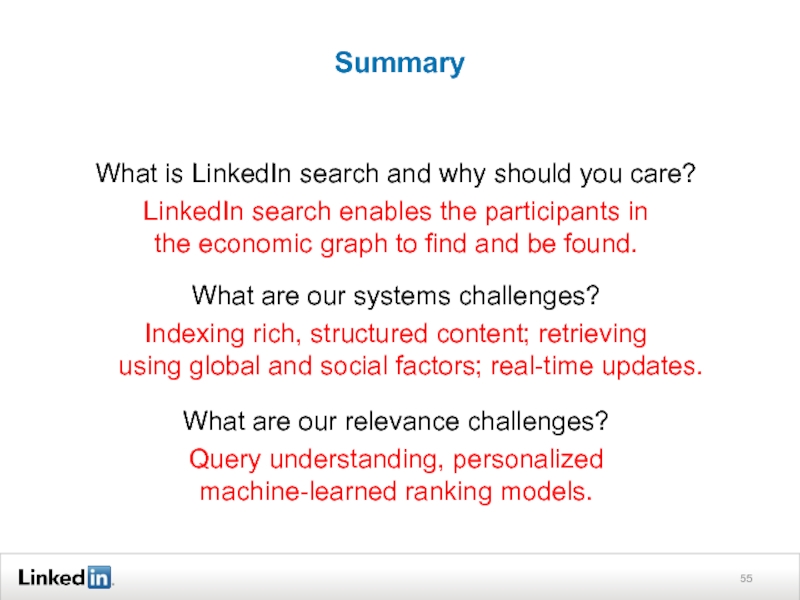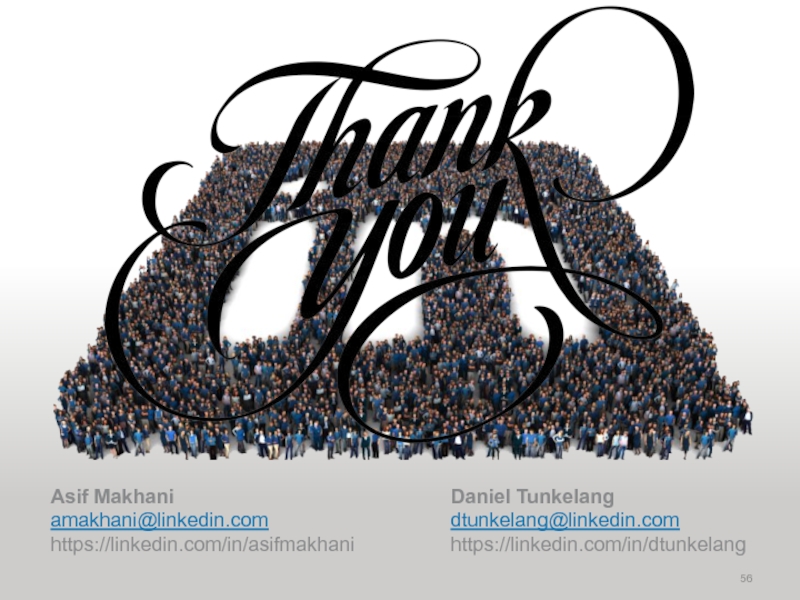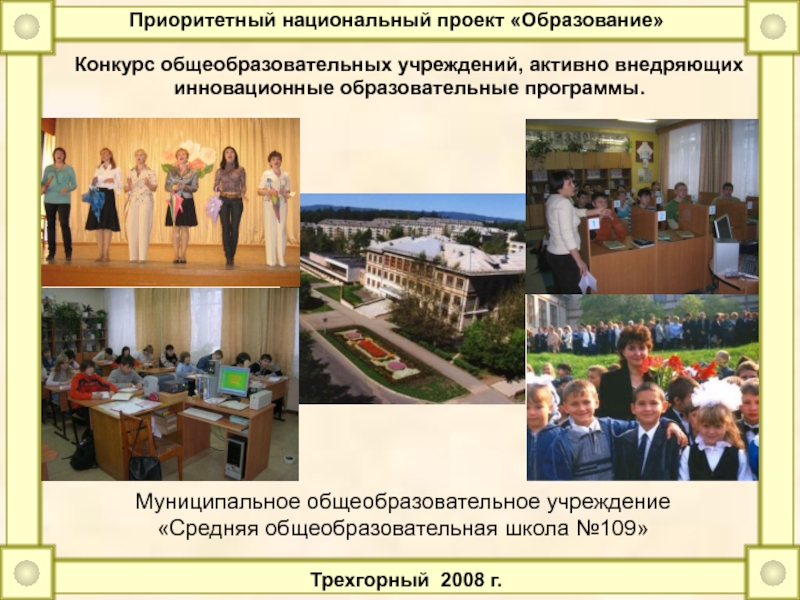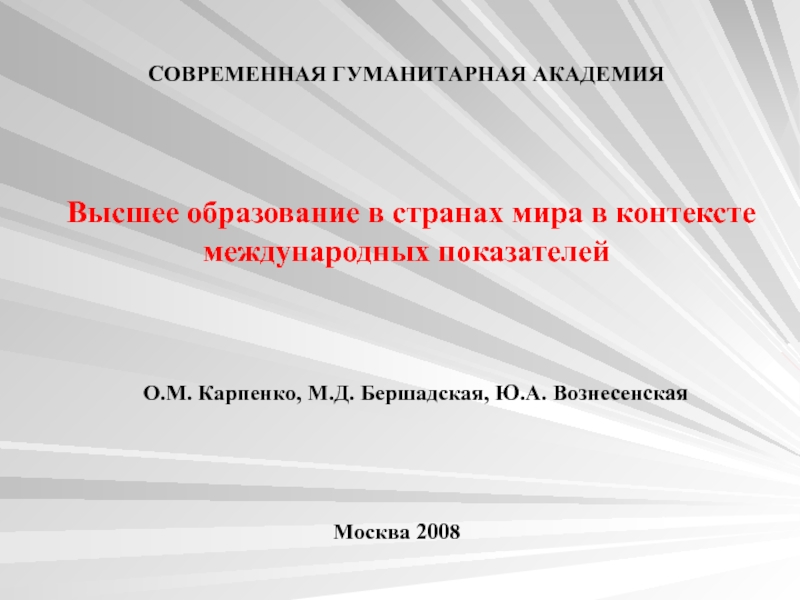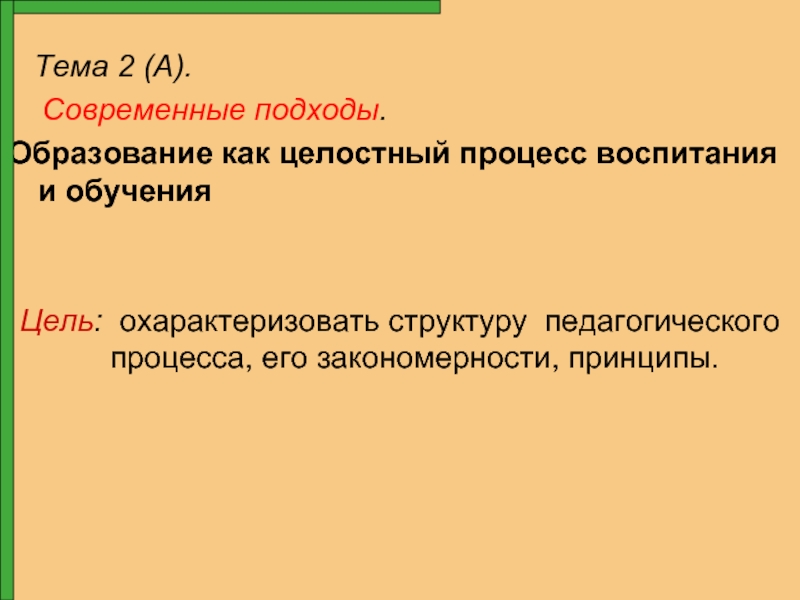- Главная
- Разное
- Дизайн
- Бизнес и предпринимательство
- Аналитика
- Образование
- Развлечения
- Красота и здоровье
- Финансы
- Государство
- Путешествия
- Спорт
- Недвижимость
- Армия
- Графика
- Культурология
- Еда и кулинария
- Лингвистика
- Английский язык
- Астрономия
- Алгебра
- Биология
- География
- Детские презентации
- Информатика
- История
- Литература
- Маркетинг
- Математика
- Медицина
- Менеджмент
- Музыка
- МХК
- Немецкий язык
- ОБЖ
- Обществознание
- Окружающий мир
- Педагогика
- Русский язык
- Технология
- Физика
- Философия
- Химия
- Шаблоны, картинки для презентаций
- Экология
- Экономика
- Юриспруденция
Structure, Personalization, Scale: A Deep Dive into LinkedIn Search презентация
Содержание
- 1. Structure, Personalization, Scale: A Deep Dive into LinkedIn Search
- 2. Overview What is LinkedIn search and
- 5. Search helps members find and be found.
- 6. Search for people, jobs, groups, and more.
- 8. A separate product for recruiters.
- 9. Search is the core of key LinkedIn use cases.
- 10. What’s unique Personalized Part of a larger
- 11. Systems Challenges
- 12. Evolution of LinkedIn’ Search Architecture 2004: No
- 13. Lucene
- 14. Lucene
- 15. Lucene
- 16. Source 1 Queries Results Updater
- 17. Source 1 Queries Results Updater
- 18. Updater Updater 2010: SenseiDB (cluster management, new query language, wrapping existing pieces)
- 19. Updater Updater 2011: Cleo (instant typeahead results)
- 20. Updater Updater 2013: Too
- 21. Challenges Index rebuilding very difficult Live
- 22. Updater Updater 2014: Introducing Galene
- 23. Life of a Query Query Rewriter/ Planner
- 24. Life of a Query – Within A Search Shard Rewritten Query Top Results From Shard
- 25. Life of a Query – Within A Rewriter
- 26. Life of Data - Offline
- 27. Improvements Regular full index builds using Hadoop
- 28. Galene Deep dive
- 29. Primer on Search
- 30. Lucene An open source API that supports
- 31. The Search Index Inverted Index: Mapping from
- 33. The Search Index The lists are called
- 34. Lucene Queries term:“asif makhani” term:asif term:daniel +term:daniel +prefix:tunk +asif +linkedIn +term:daniel connection:50510 +term:daniel industry:software connection:50510^4
- 35. Early termination We order documents in the
- 36. Partial Updates Lucene segments are “document-partitioned” We
- 38. Going Forward Consolidation across verticals Improved Relevance
- 39. Quality Challenges
- 40. The Search Quality Pipeline spellcheck query tagging vertical intent query expansion
- 41. Spellcheck PEOPLE NAMES COMPANIES TITLES
- 42. Query Tagging machine learning data scientist brooklyn
- 43. Vertical Intent: Results Blending [company] [employees] [jobs] [name search]
- 44. Vertical Intent: Typeahead P(mongodb |
- 45. Query Expansion
- 46. Ranking
- 47. Ranking is highly personalized.
- 48. Not just for name search.
- 49. Relevance Model
- 50. Examples of Features Search keywords matching title
- 51. Model Training: Traditional Approach
- 52. Model Training: LinkedIn’s Approach
- 53. Fair Pairs and Easy Negatives Sample negatives
- 54. Model Selection Select model based on user
- 55. Summary What is LinkedIn search and
- 56. Asif Makhani Daniel Tunkelang amakhani@linkedin.com dtunkelang@linkedin.com https://linkedin.com/in/asifmakhani https://linkedin.com/in/dtunkelang
Слайд 2Overview
What is LinkedIn search and why should you care?
What are our
What are our relevance challenges?
Слайд 10What’s unique
Personalized
Part of a larger product experience
Many products
Big part
Task-centric
Find a job,
Слайд 12Evolution of LinkedIn’ Search Architecture
2004:
No Search Engine
Iterate through your network and
Слайд 13
Lucene
Lucene
Lucene
Lucene
(Single Shard)
Updates
Queries
Results
2007: Introducing
Слайд 14
Lucene
Lucene
Lucene
Updates
Queries
Results
Updater
Updater
Lucene
Zoie
2008: Zoie - real-time search (search without commits/shutdown)
Слайд 15
Lucene
Lucene
Lucene
Source 1
Queries
Results
Updater
Updater
Lucene
Zoie
Source 2
….
Source N
Content Store
….
2008: Content Store (aggregating multiple input sources)
Слайд 16
Source 1
Queries
Results
Updater
Updater
Source 2
….
Source N
Content Store
….
Sharded
Broker
2008: Sharded search
Слайд 17
Source 1
Queries
Results
Updater
Updater
Source 2
….
Source N
Content Store
….
Sensei
Broker
Lucene
Zoie
Bobo
2009: Bobo –
Слайд 18
Updater
Updater
2010: SenseiDB (cluster management, new query language, wrapping existing pieces)
Слайд 21Challenges
Index rebuilding very difficult
Live updates are at an entity granularity
Scoring
Lucene limitations
Fragmentation – too many components, too many stacks
Economic Graph
Opportunity
Слайд 23Life of a Query
Query Rewriter/
Planner
Results
Merging
User
Query
Search
Results
Search Shard
Search Shard
Слайд 26
Life of Data - Offline
INDEX
Derived Data
Raw Data
DATA
MODEL
DATA
MODEL
DATA
MODEL
DATA
MODEL
DATA
MODEL
Слайд 27Improvements
Regular full index builds using Hadoop
Easier to reshard, add fields
Improved Relevance
Offline
Partial Live Updates Support
Allows efficient updates of high frequency fields (no sync)
Goodbye Content Store, Goodbye Zoie
Early termination
Ultra low latency for instant results
Goodbye Cleo
Indexing and searching across graph entities/attributes
Single engine, single stack
Слайд 30Lucene
An open source API that supports search functionality:
Add new documents to
Delete documents from the index
Construct queries
Search the index using the query
Score the retrieved documents
Слайд 31The Search Index
Inverted Index: Mapping from (search) terms to list of
Forward Index: Mapping from documents to metadata about them
Слайд 33The Search Index
The lists are called posting lists
Upto hundreds of millions
Upto hundreds of millions of documents
Posting lists may contain as few as a single hit and as many as tens of millions of hits
Terms can be
words in the document
inferred attributes about the document
Слайд 34Lucene Queries
term:“asif makhani”
term:asif term:daniel
+term:daniel +prefix:tunk
+asif +linkedIn
+term:daniel connection:50510
+term:daniel industry:software connection:50510^4
Слайд 35Early termination
We order documents in the index based on a static
An offline relevance algorithm assigns a static rank to each document on which the sorting is performed
This allows retrieval to be early-terminated (assuming a strong correlation between static rank and importance of result for a specific query)
Also works well with personalized search
+term:asif +prefix:makh +(connection:35176 connection:418001 connection:1520032)
Слайд 36Partial Updates
Lucene segments are “document-partitioned”
We have enhanced Lucene with “term-partitioned” segments
We
Base index (never changed)
Live update buffer
Snapshot index
Слайд 38Going Forward
Consolidation across verticals
Improved Relevance Support
Machine-learned models, query rewriting, relevant snippets,…
Improved
Search as a Service (SeaS)
Exploring the Economic Graph
Слайд 41Spellcheck
PEOPLE NAMES
COMPANIES
TITLES
PAST QUERIES
n-grams
marissa => ma ar ri is ss sa
metaphone
mark/marc =>
co-occurrence counts
marissa:mayer = 1000
marisa meyer yahoo
marissa
marisa
meyer
mayer
yahoo
Слайд 44Vertical Intent: Typeahead
P(mongodb | mon) = 5%
P(monsanto | mons): 50%
P(mongodb |
Слайд 50Examples of Features
Search keywords matching title = 3
Searcher location = Result
Searcher network distance to result = 2
…
Слайд 53Fair Pairs and Easy Negatives
Sample negatives from bottom results
But watch out
Compromise, e.g., sample from page 10.
Слайд 54Model Selection
Select model based on user and query features.
e.g., person name
Resulting model is a tree with logistic regression leaves.
Only one regression model evaluated for each document.
Слайд 55Summary
What is LinkedIn search and why should you care?
LinkedIn search enables
What are our systems challenges?
Indexing rich, structured content; retrieving using global and social factors; real-time updates.
What are our relevance challenges?
Query understanding, personalized machine-learned ranking models.

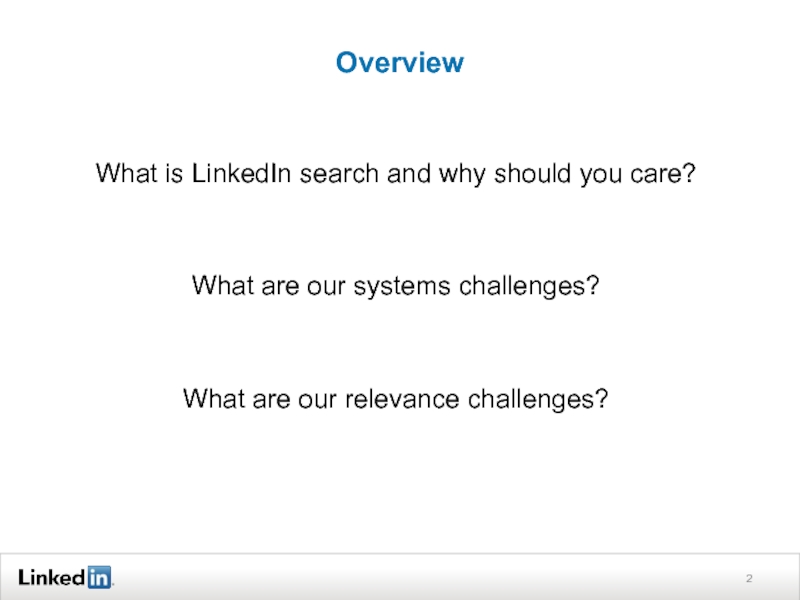


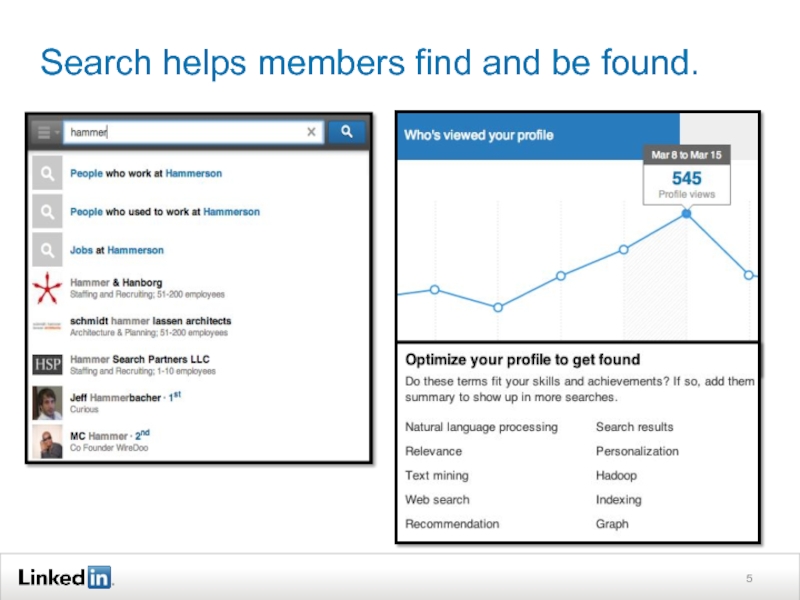
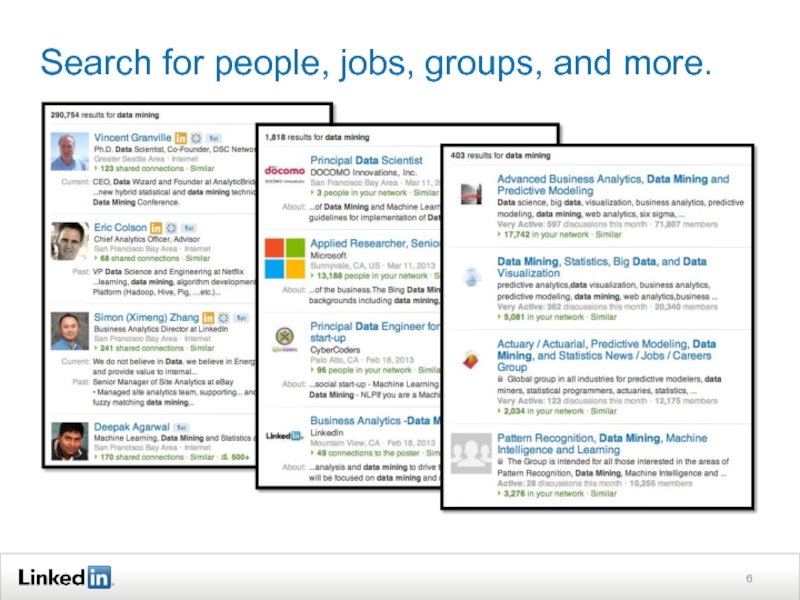

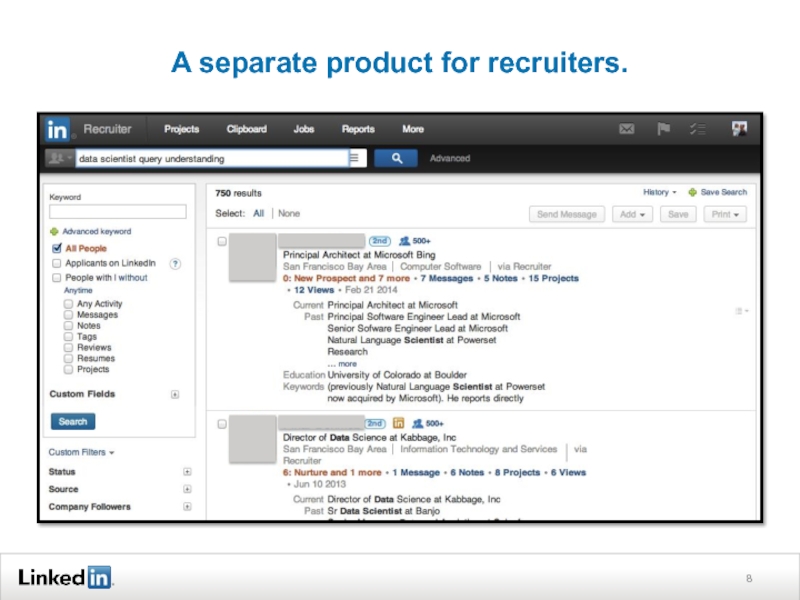
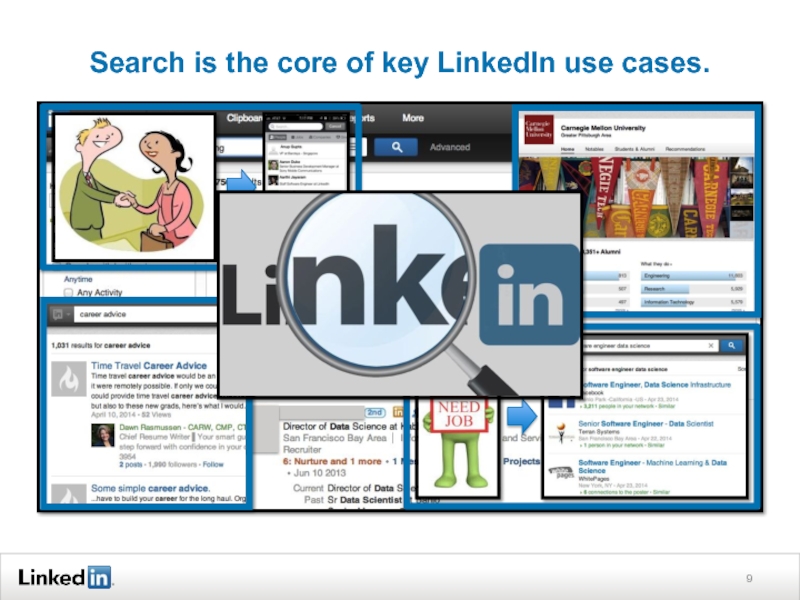
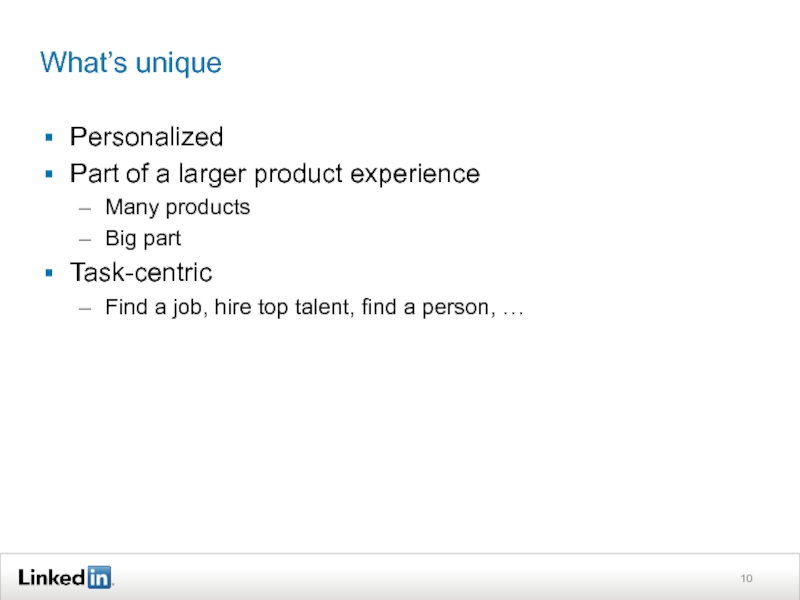

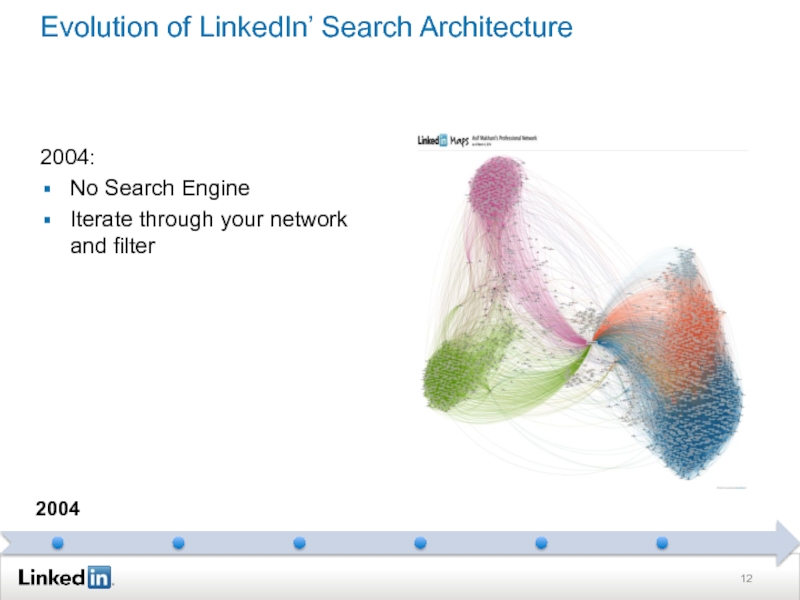

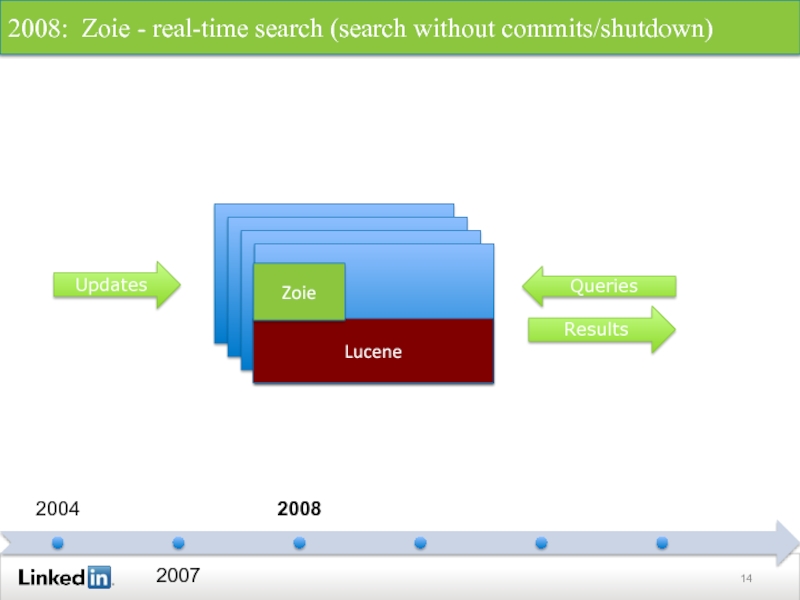
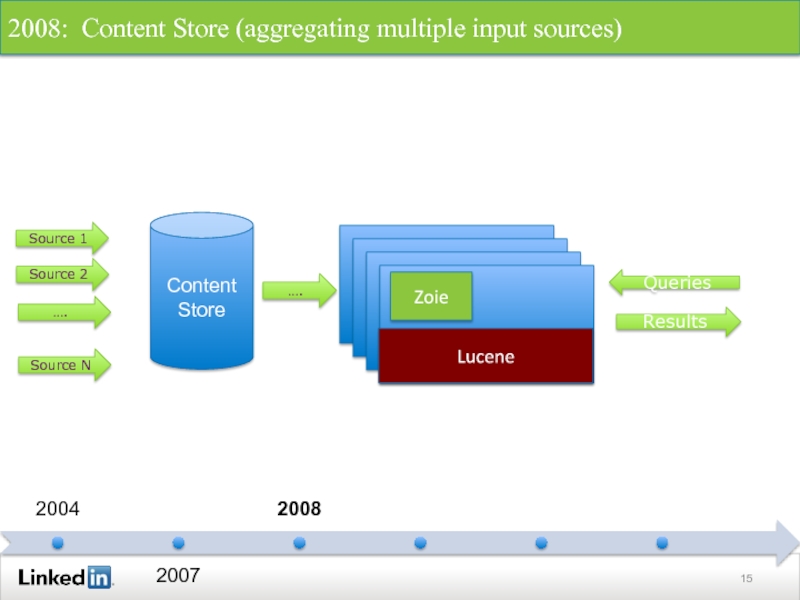
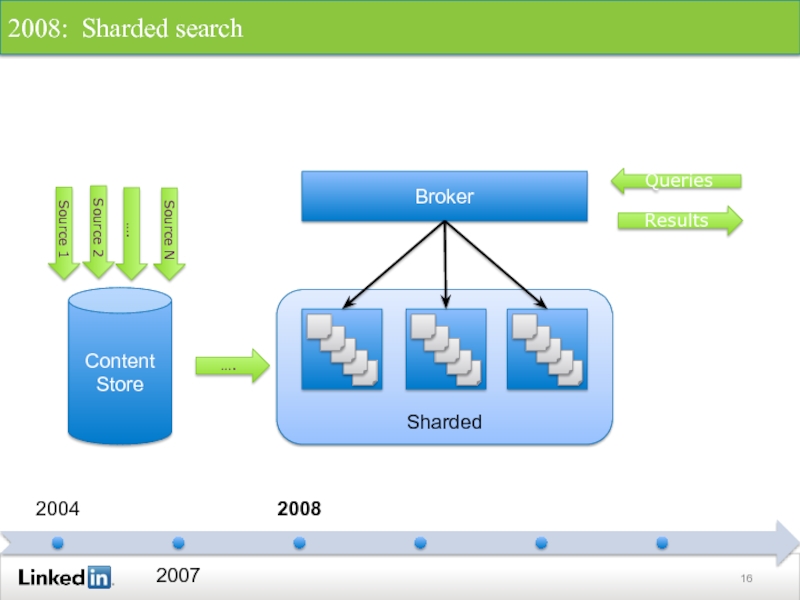
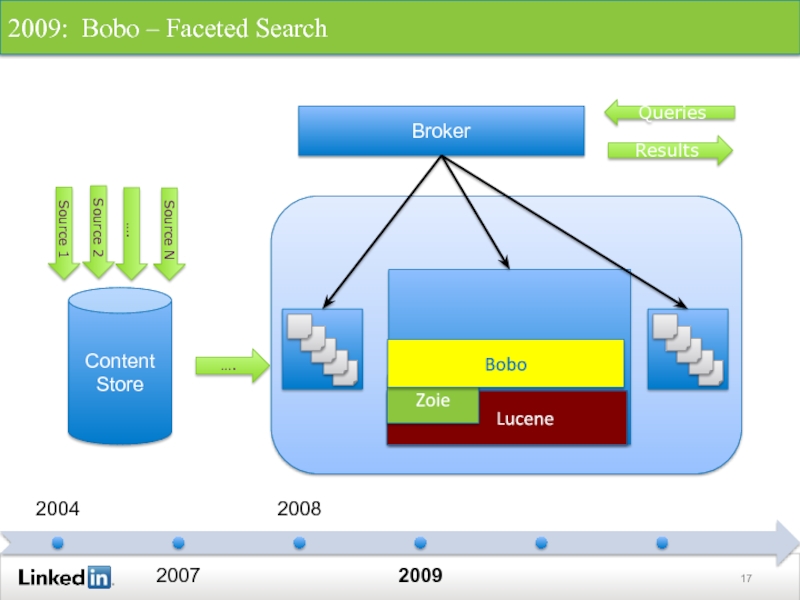
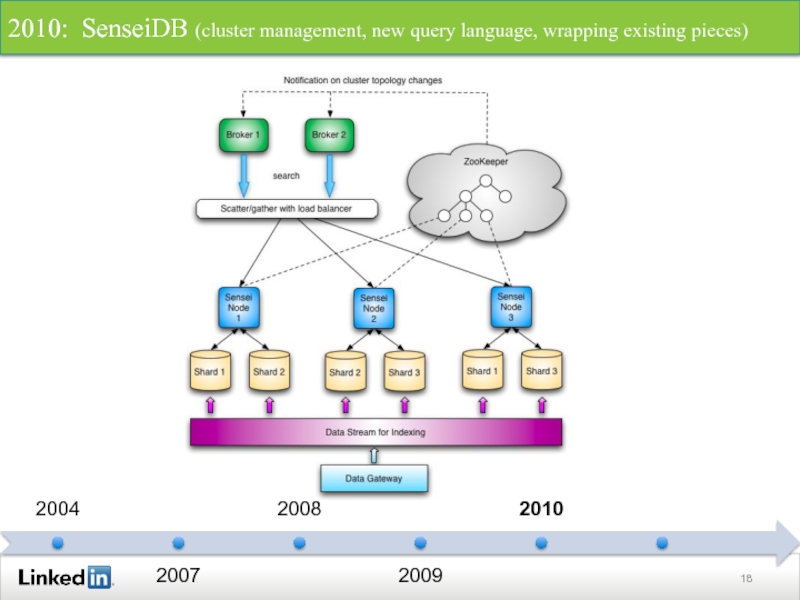
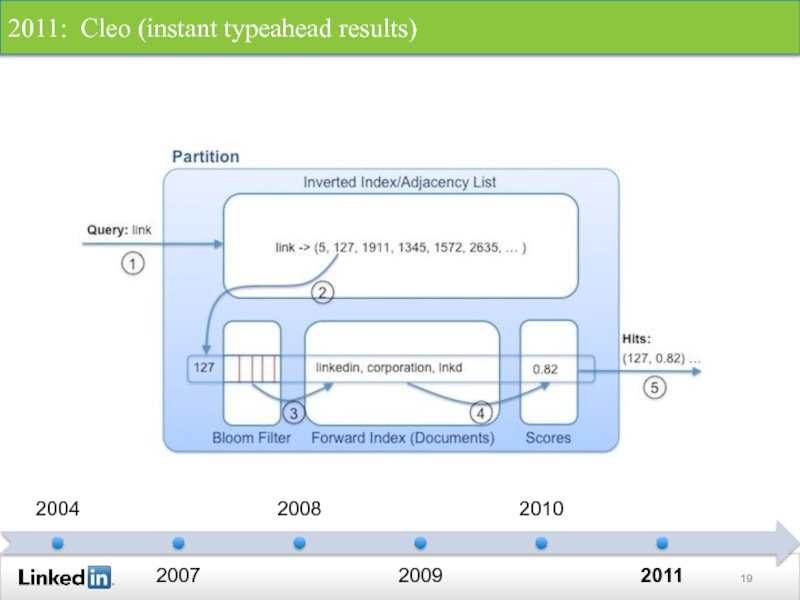
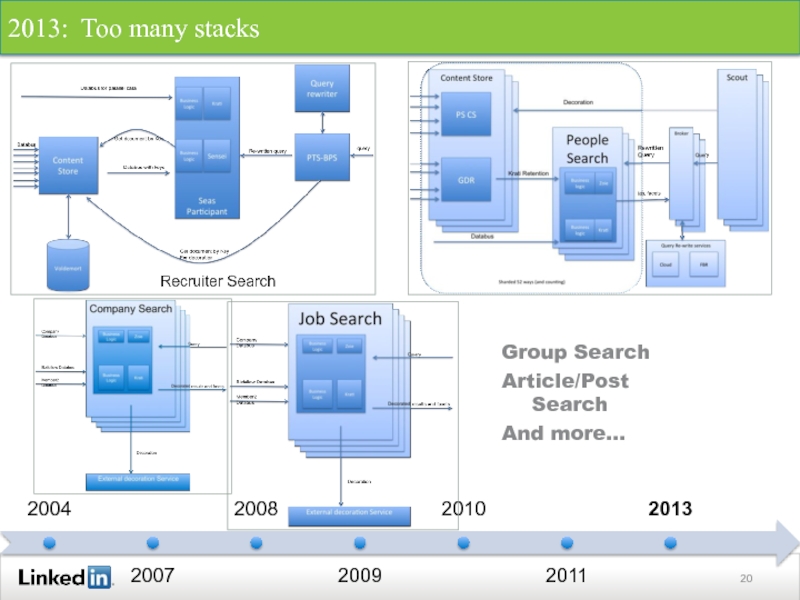
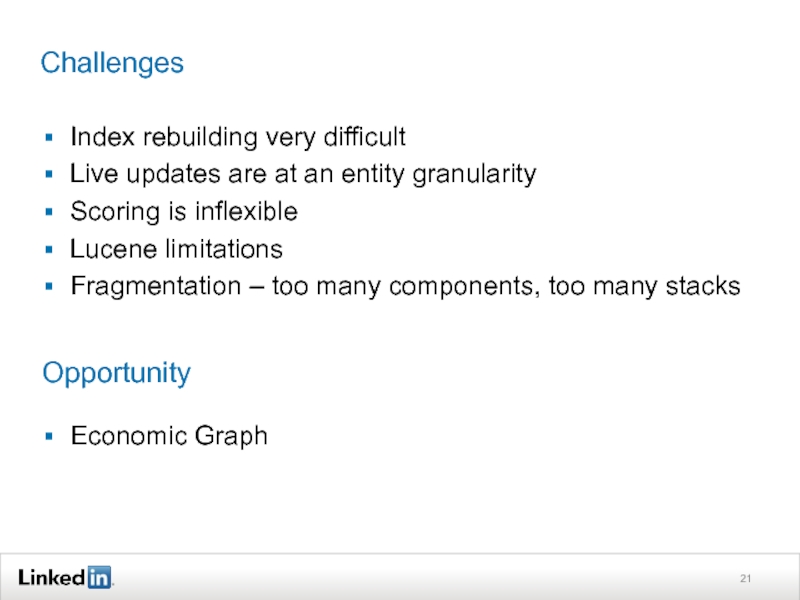
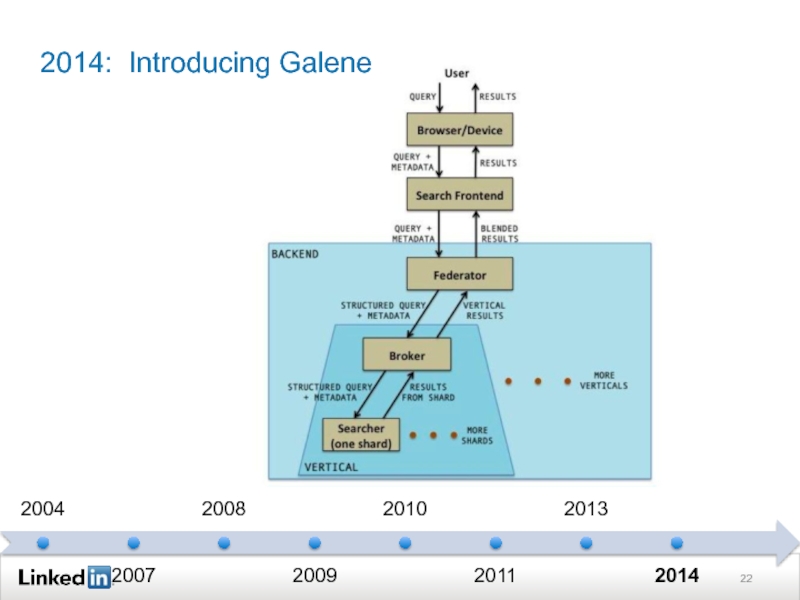
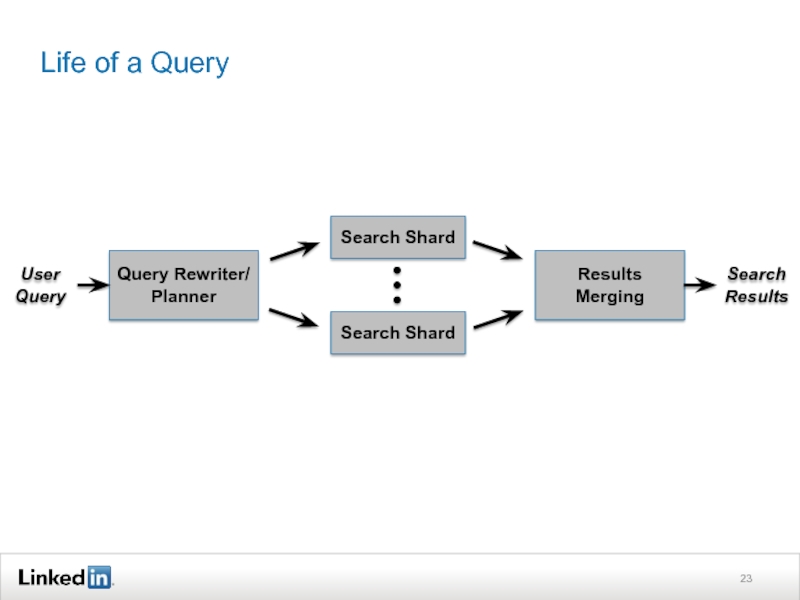


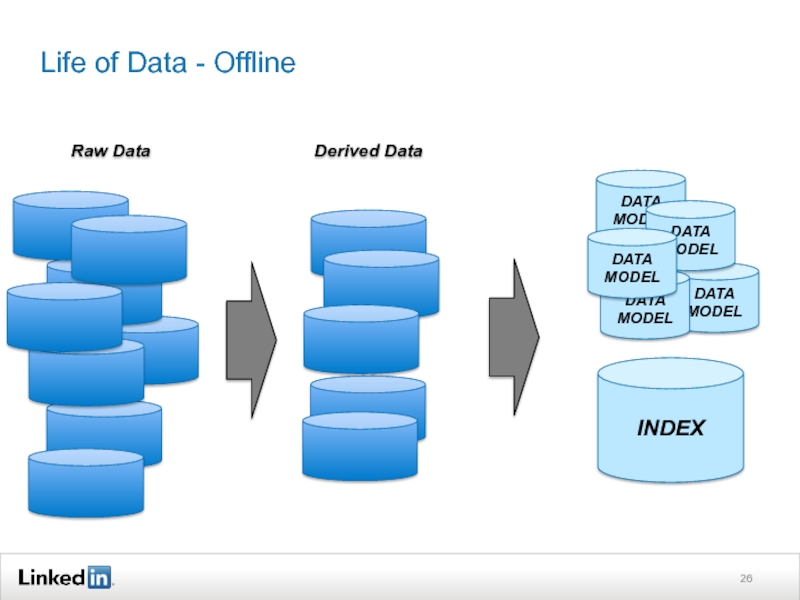
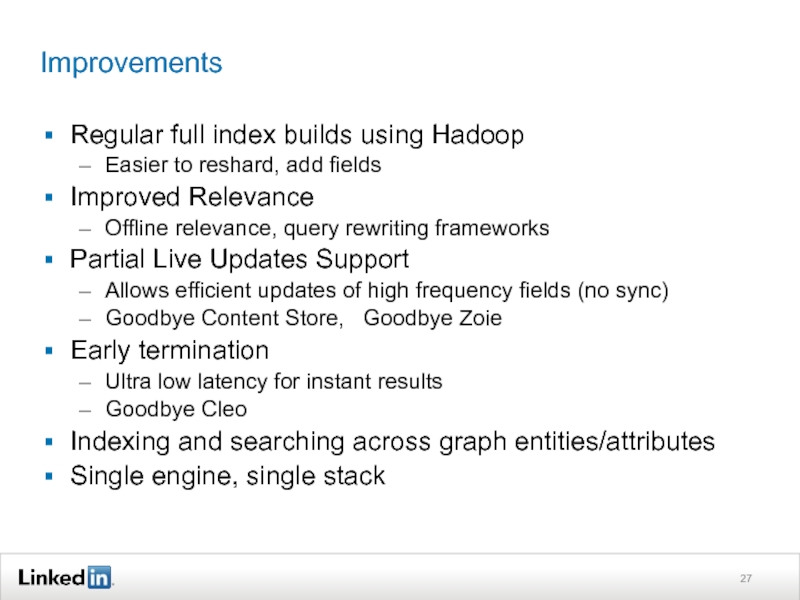
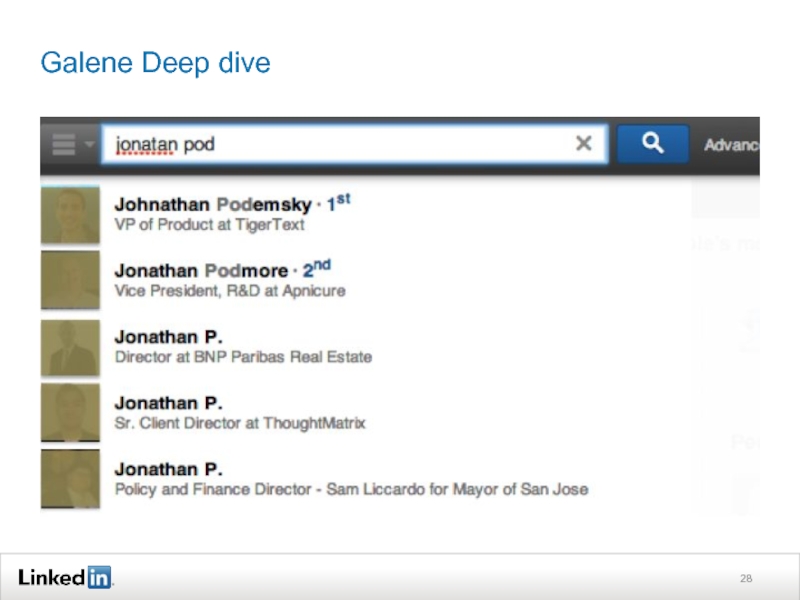

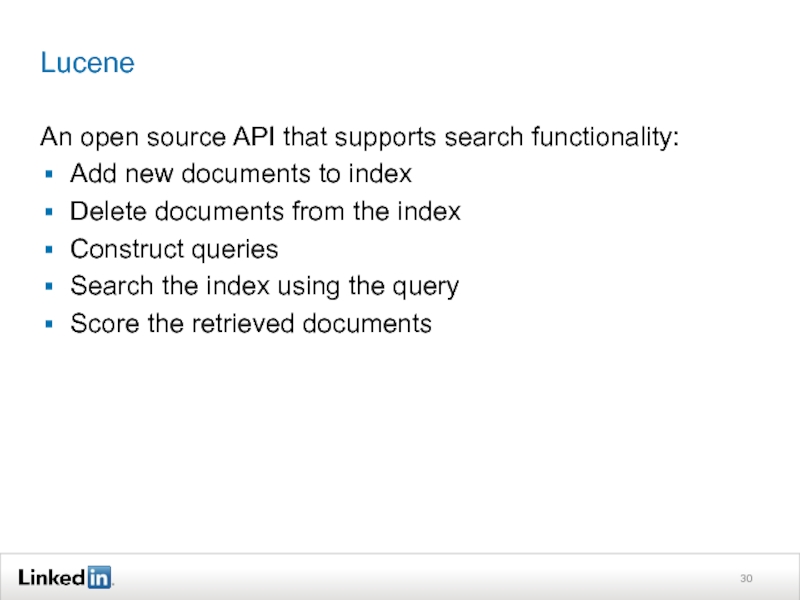
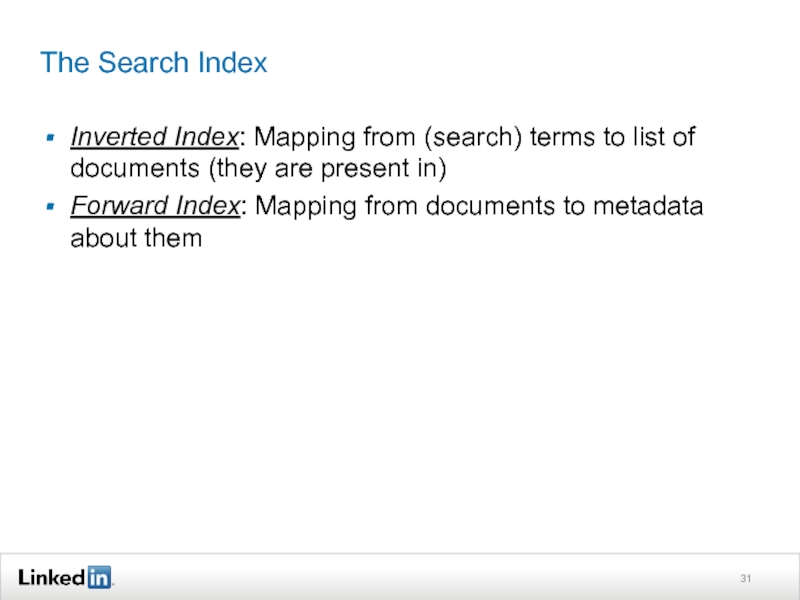
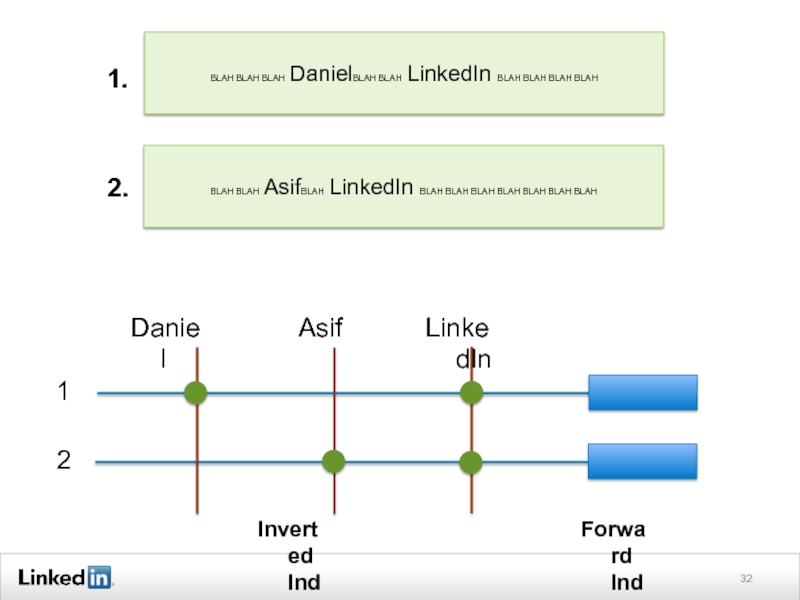
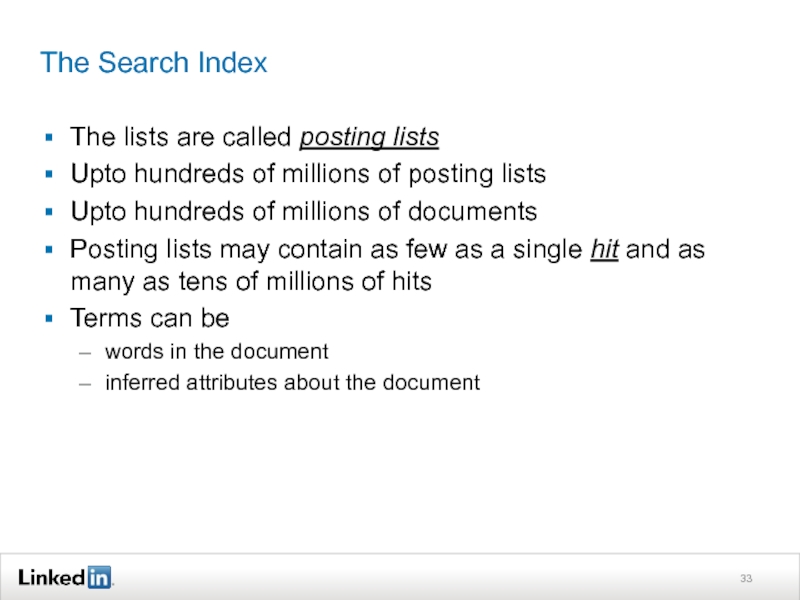
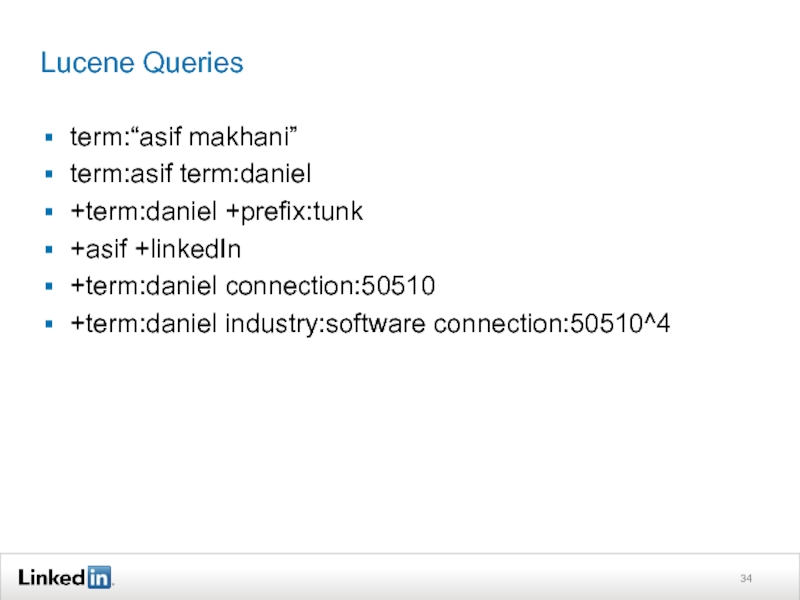
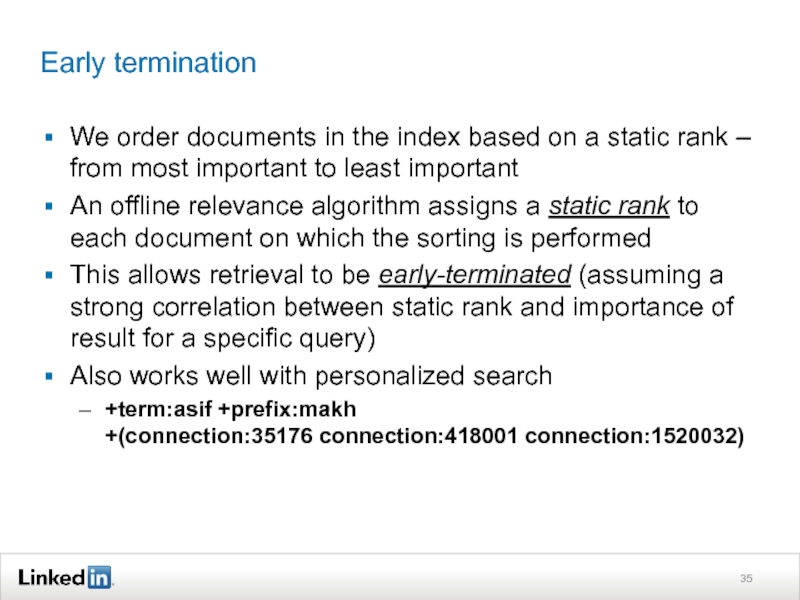
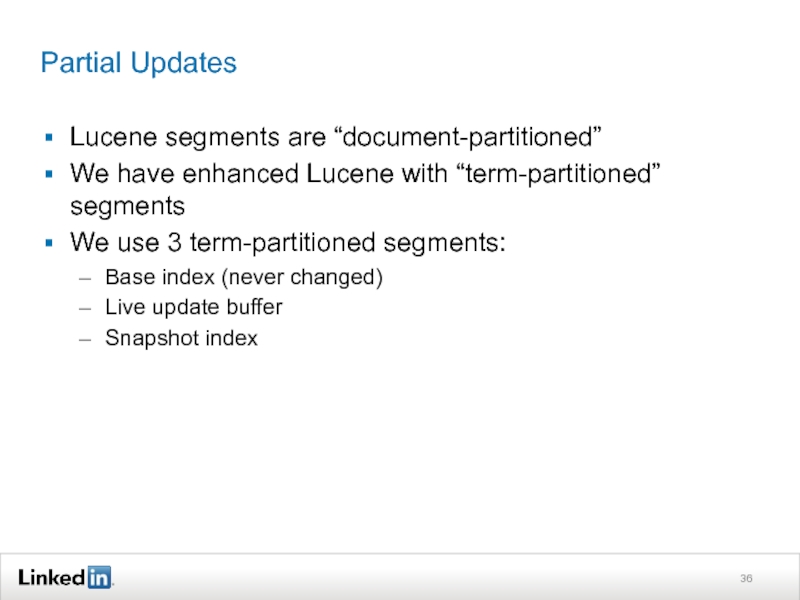
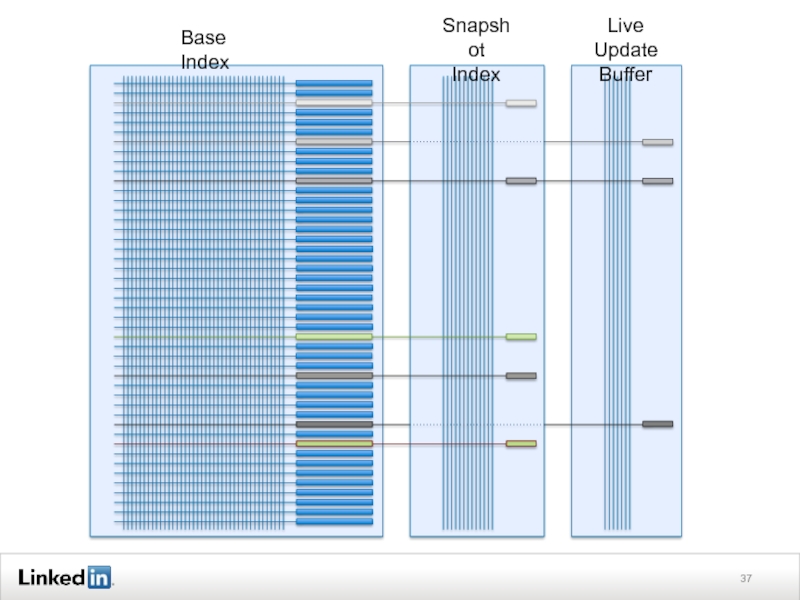

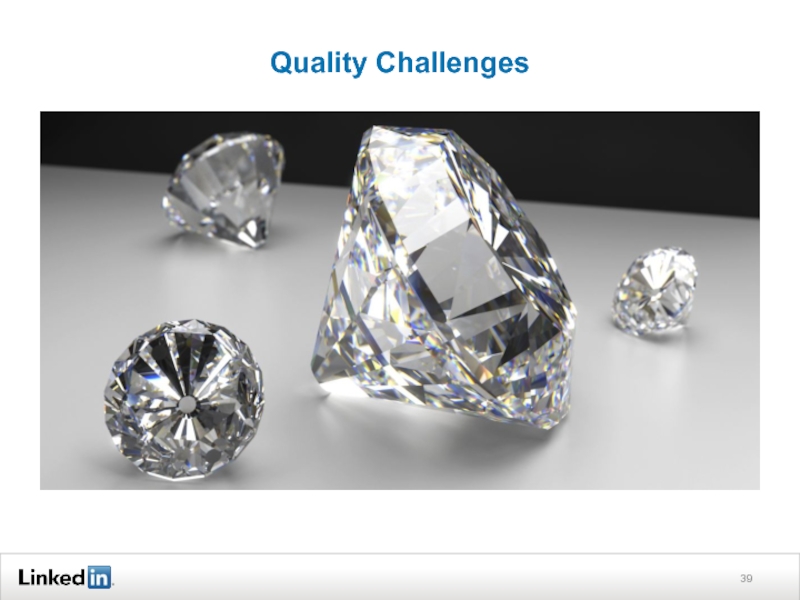
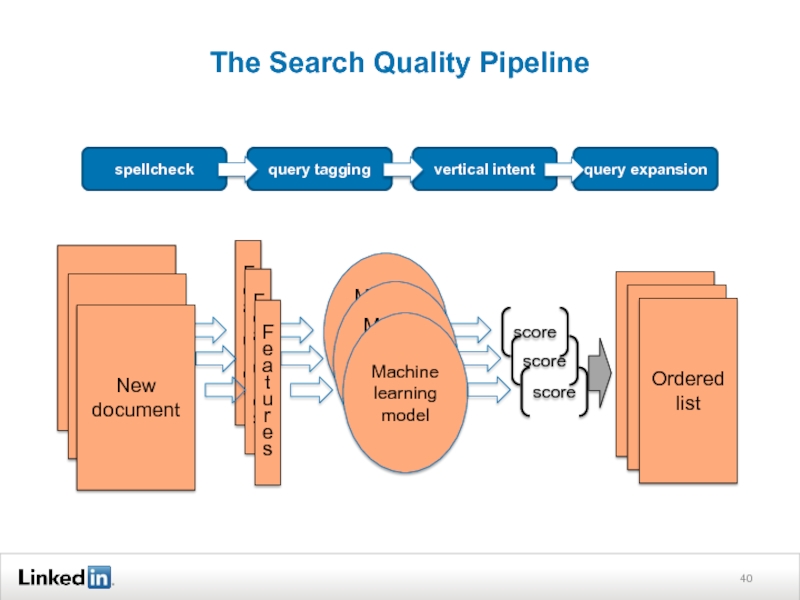
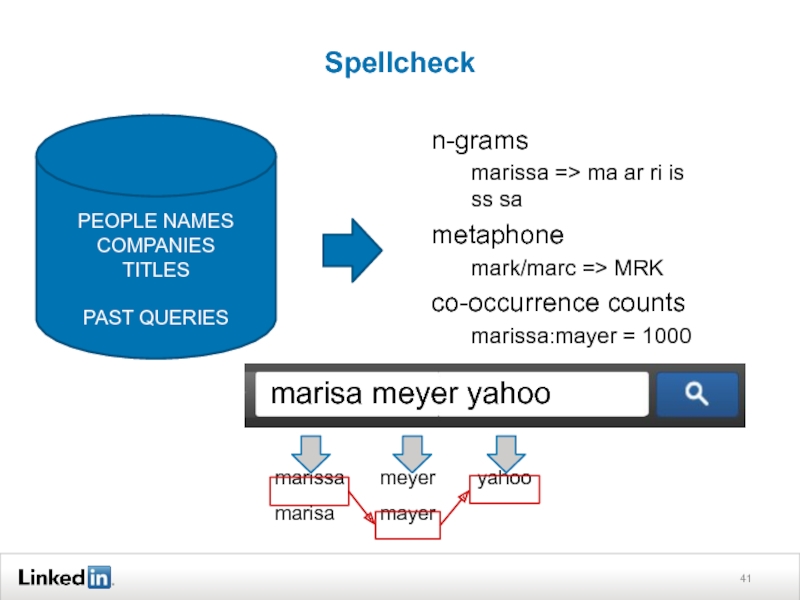
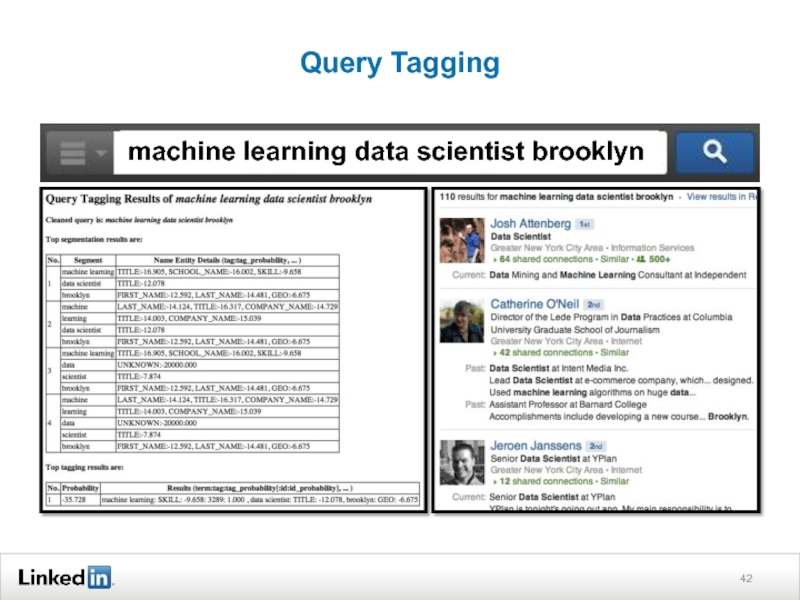
![Vertical Intent: Results Blending[company][employees][jobs][name search]](/img/tmb/3/259587/1f5d5e214908d804e2117ca6052dc6ec-800x.jpg)
